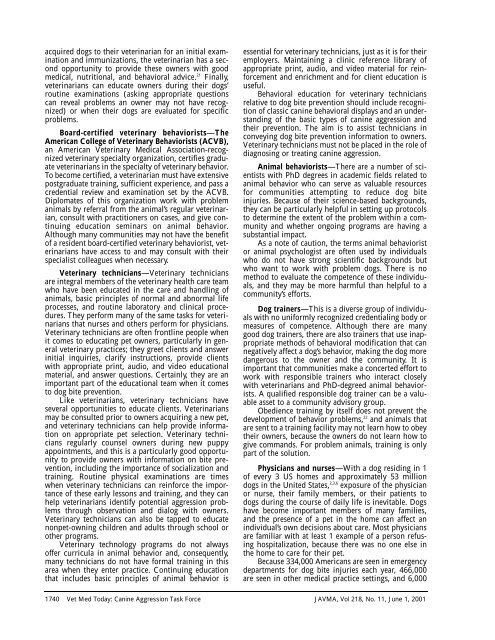A community approach to dog bite prevention - American Veterinary ...
A community approach to dog bite prevention - American Veterinary ...
A community approach to dog bite prevention - American Veterinary ...
Create successful ePaper yourself
Turn your PDF publications into a flip-book with our unique Google optimized e-Paper software.
acquired <strong>dog</strong>s <strong>to</strong> their veterinarian for an initial examination<br />
and immunizations, the veterinarian has a second<br />
opportunity <strong>to</strong> provide these owners with good<br />
medical, nutritional, and behavioral advice. 21 Finally,<br />
veterinarians can educate owners during their <strong>dog</strong>s’<br />
routine examinations (asking appropriate questions<br />
can reveal problems an owner may not have recognized)<br />
or when their <strong>dog</strong>s are evaluated for specific<br />
problems.<br />
Board-certified veterinary behaviorists—The<br />
<strong>American</strong> College of <strong>Veterinary</strong> Behaviorists (ACVB),<br />
an <strong>American</strong> <strong>Veterinary</strong> Medical Association-recognized<br />
veterinary specialty organization, certifies graduate<br />
veterinarians in the specialty of veterinary behavior.<br />
To become certified, a veterinarian must have extensive<br />
postgraduate training, sufficient experience, and pass a<br />
credential review and examination set by the ACVB.<br />
Diplomates of this organization work with problem<br />
animals by referral from the animal’s regular veterinarian,<br />
consult with practitioners on cases, and give continuing<br />
education seminars on animal behavior.<br />
Although many communities may not have the benefit<br />
of a resident board-certified veterinary behaviorist, veterinarians<br />
have access <strong>to</strong> and may consult with their<br />
specialist colleagues when necessary.<br />
<strong>Veterinary</strong> technicians—<strong>Veterinary</strong> technicians<br />
are integral members of the veterinary health care team<br />
who have been educated in the care and handling of<br />
animals, basic principles of normal and abnormal life<br />
processes, and routine labora<strong>to</strong>ry and clinical procedures.<br />
They perform many of the same tasks for veterinarians<br />
that nurses and others perform for physicians.<br />
<strong>Veterinary</strong> technicians are often frontline people when<br />
it comes <strong>to</strong> educating pet owners, particularly in general<br />
veterinary practices; they greet clients and answer<br />
initial inquiries, clarify instructions, provide clients<br />
with appropriate print, audio, and video educational<br />
material, and answer questions. Certainly, they are an<br />
important part of the educational team when it comes<br />
<strong>to</strong> <strong>dog</strong> <strong>bite</strong> <strong>prevention</strong>.<br />
Like veterinarians, veterinary technicians have<br />
several opportunities <strong>to</strong> educate clients. Veterinarians<br />
may be consulted prior <strong>to</strong> owners acquiring a new pet,<br />
and veterinary technicians can help provide information<br />
on appropriate pet selection. <strong>Veterinary</strong> technicians<br />
regularly counsel owners during new puppy<br />
appointments, and this is a particularly good opportunity<br />
<strong>to</strong> provide owners with information on <strong>bite</strong> <strong>prevention</strong>,<br />
including the importance of socialization and<br />
training. Routine physical examinations are times<br />
when veterinary technicians can reinforce the importance<br />
of these early lessons and training, and they can<br />
help veterinarians identify potential aggression problems<br />
through observation and dialog with owners.<br />
<strong>Veterinary</strong> technicians can also be tapped <strong>to</strong> educate<br />
nonpet-owning children and adults through school or<br />
other programs.<br />
<strong>Veterinary</strong> technology programs do not always<br />
offer curricula in animal behavior and, consequently,<br />
many technicians do not have formal training in this<br />
area when they enter practice. Continuing education<br />
that includes basic principles of animal behavior is<br />
essential for veterinary technicians, just as it is for their<br />
employers. Maintaining a clinic reference library of<br />
appropriate print, audio, and video material for reinforcement<br />
and enrichment and for client education is<br />
useful.<br />
Behavioral education for veterinary technicians<br />
relative <strong>to</strong> <strong>dog</strong> <strong>bite</strong> <strong>prevention</strong> should include recognition<br />
of classic canine behavioral displays and an understanding<br />
of the basic types of canine aggression and<br />
their <strong>prevention</strong>. The aim is <strong>to</strong> assist technicians in<br />
conveying <strong>dog</strong> <strong>bite</strong> <strong>prevention</strong> information <strong>to</strong> owners.<br />
<strong>Veterinary</strong> technicians must not be placed in the role of<br />
diagnosing or treating canine aggression.<br />
Animal behaviorists—There are a number of scientists<br />
with PhD degrees in academic fields related <strong>to</strong><br />
animal behavior who can serve as valuable resources<br />
for communities attempting <strong>to</strong> reduce <strong>dog</strong> <strong>bite</strong><br />
injuries. Because of their science-based backgrounds,<br />
they can be particularly helpful in setting up pro<strong>to</strong>cols<br />
<strong>to</strong> determine the extent of the problem within a <strong>community</strong><br />
and whether ongoing programs are having a<br />
substantial impact.<br />
As a note of caution, the terms animal behaviorist<br />
or animal psychologist are often used by individuals<br />
who do not have strong scientific backgrounds but<br />
who want <strong>to</strong> work with problem <strong>dog</strong>s. There is no<br />
method <strong>to</strong> evaluate the competence of these individuals,<br />
and they may be more harmful than helpful <strong>to</strong> a<br />
<strong>community</strong>’s efforts.<br />
Dog trainers—This is a diverse group of individuals<br />
with no uniformly recognized credentialing body or<br />
measures of competence. Although there are many<br />
good <strong>dog</strong> trainers, there are also trainers that use inappropriate<br />
methods of behavioral modification that can<br />
negatively affect a <strong>dog</strong>’s behavior, making the <strong>dog</strong> more<br />
dangerous <strong>to</strong> the owner and the <strong>community</strong>. It is<br />
important that communities make a concerted effort <strong>to</strong><br />
work with responsible trainers who interact closely<br />
with veterinarians and PhD-degreed animal behaviorists.<br />
A qualified responsible <strong>dog</strong> trainer can be a valuable<br />
asset <strong>to</strong> a <strong>community</strong> advisory group.<br />
Obedience training by itself does not prevent the<br />
development of behavior problems, 22 and animals that<br />
are sent <strong>to</strong> a training facility may not learn how <strong>to</strong> obey<br />
their owners, because the owners do not learn how <strong>to</strong><br />
give commands. For problem animals, training is only<br />
part of the solution.<br />
Physicians and nurses—With a <strong>dog</strong> residing in 1<br />
of every 3 US homes and approximately 53 million<br />
<strong>dog</strong>s in the United States, 2,3,6 exposure of the physician<br />
or nurse, their family members, or their patients <strong>to</strong><br />
<strong>dog</strong>s during the course of daily life is inevitable. Dogs<br />
have become important members of many families,<br />
and the presence of a pet in the home can affect an<br />
individual’s own decisions about care. Most physicians<br />
are familiar with at least 1 example of a person refusing<br />
hospitalization, because there was no one else in<br />
the home <strong>to</strong> care for their pet.<br />
Because 334,000 <strong>American</strong>s are seen in emergency<br />
departments for <strong>dog</strong> <strong>bite</strong> injuries each year, 466,000<br />
are seen in other medical practice settings, and 6,000<br />
1740 Vet Med Today: Canine Aggression Task Force JAVMA, Vol 218, No. 11, June 1, 2001










